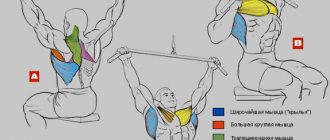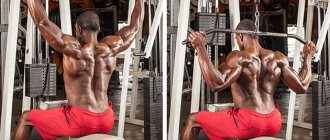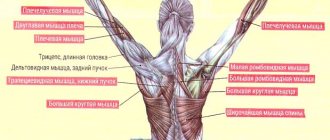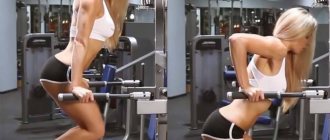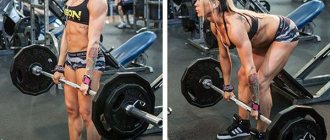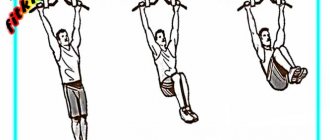November 19, 2015 Admin Home page » Lat + upper back
The exercise technique, starting position, working muscles, main mistakes, important recommendations + video for the ideal execution technique are described.
Description of the exercise
A variation of the bent-over barbell row exercise, a less traumatic exercise, thickens the back muscles, giving them volume, but does not give such an increase in mass as when working with a barbell.
Some keep their body straight when extending their arms, others allow the weight to slightly tilt their back forward, thus stretching the back muscles more, it’s up to you to choose, but when pulling the block to your belt, be sure to bend your lower back a little, sticking your chest out forward, pull your shoulder blades together, pull your shoulders back and hold back straight.
How to do the exercise correctly
In order for the exercise to be performed correctly, you first need to set up the machine so that when working with it, the traction cable is parallel to the floor.
Starting position: arms extended forward, palms facing each other and firmly holding the handles of the block. The legs are slightly bent at the knees and rest firmly on the supports. The back is kept straight, the athlete looks straight ahead.
- Phase one. The pulling begins - you need to try to pull precisely through the isolated movement of the elbows - that is, using the latissimus dorsi muscles. As soon as the elbows are level with the body, the first phase of the movement is completed.
- The second phase - the elbows continue to move and extend far beyond the line of the body. The shoulder blades are brought together as much as possible. The lats should contract as much as possible.
- The third phase is a delay for a couple of seconds with static tension in the muscles.
- The fourth phase is the final one. The arms return in a smooth, controlled movement to the starting position. The back should not be rounded.
If the exercise is performed with really heavy weights, the use of straps is acceptable.
Main mistakes
• Bent back – the load on the back muscles will be minimal, and the danger of injuring the lower back will be maximum;
• When pulling the block to the belt, the torso leans strongly back - the weight is too heavy, reduce it, since you pull the load not with your back, but by straightening your lower back, you will get injured;
• Elbows move to the side - the load is redistributed to the trapezius, turning off the latissimus muscles.
• A jerk at the beginning of the movement and a sharp lowering back - all movements are controlled, otherwise with a significant load you will earn microtraumas to the back and elbow joints.
Technique
The technique of working on a block and lever simulator is slightly different. There are two variations of the exercise - one-arm and two-arm rows.
Horizontal abdominal row with 2 arms in a block machine
It is possible to pull a horizontal block with a narrow and wide grip. For a narrow grip, it is advisable to use a special L-shaped handle. With a narrow grip, the elbows are directed to the sides, with a grip at shoulder level - down. The movement begins with tightening the shoulder blades to the spine and actively engaging the back muscles. Next, the elbows are carefully brought into the plane of the spine and the pull reaches the body. Then the muscles are gradually relaxed, the handle of the simulator is returned to its original position.
1 arm row
The one-arm row differs in that the handle for rowing is taken with one hand, and the free hand is calmly located along the body. It is necessary to significantly tense the abdominal muscles so that there is no strong rotation along the axis of the spine; natural rotation is allowed.
Important Tips
1) Use different blocks for rowing - except for the block when the hands are directed inward with a neutral grip, use a horizontal handle, alternating between a narrow, medium and wide grip, just change not during the workout, but during different workouts, this will allow you to include different muscles in the work .
2) Don’t chase records - select the working weight so that you can do a clean 8 repetitions.
3) Do not straighten your legs - they are always slightly bent; when performing seated pull-downs, use only your arms and back muscles, keep your legs motionless until the end of the exercise.
4) Elbows move near the body - bring the elbow joints as close to the body as possible, you should feel them practically rubbing against your sides.
Content
- 1 Purpose of the exercise
- 2 How to do the exercise correctly
- 3 Common mistakes and recommendations
- 4 Working muscles
- 5 Technique 5.1 Horizontal abdominal row with 2 arms in a block simulator
- 5.2 1 arm row
- 5.3 Rows on a lever machine
Pulling a block to the abdomen on a simulator
Pulling a block to the abdomen on a simulator
The horizontal block row to the stomach on the machine is an exercise for the back. It is performed in two technical versions, the choice depends on the type of simulator and the purpose of the exercise. It is used both in training for beginners to learn deadlifts, and in training for more experienced athletes. Often used to correct muscle imbalances.
Execution Rules
To avoid back problems and to get maximum effect, seated rows should be performed correctly. Technique:
- adjust the seat so that the cable is parallel to the floor while driving. Then take the starting position;
- Place your feet on the support part of the machine (located in the front part). The presence of such a stand is an opportunity to minimize the risk of the buttocks slipping from the seat;
- the handles on the simulator can be of various types - separate or fixed. When performing work, make sure that your palms “look” at each other;
- After taking the initial position and placing your feet on the support, grab the handle. The arms should be straightened as much as possible, and the elbow part should be extended. A slight deflection in the lumbar region is allowed, but at the same time the back is as flat as possible. Pay special attention to your shoulders - they should be straightened. To give most of the load to the muscles, move your chest slightly forward;
- The peculiarity of cravings while sitting on the stomach is that it begins with a negative phase. Therefore, bring the handle to the torso and then exhale. Many athletes go the other way - when they pull the handle towards their stomach, they, on the contrary, draw in air. It is believed that this option can guarantee better contraction of the latissimus muscles. To determine the best option for yourself, try both methods. The ideal result is if the exercise allows you to achieve a burning sensation in the muscle fibers;
- the completion of the first phase occurs at the moment when the back muscles (the broadest group) contract the most. This is guaranteed if the elbows are positioned vertically in relation to the torso. At the same time, at the peak point they should move back a little;
- as soon as the handle touches the lower abdomen, and all the manipulations described above are completed, hold this position for some time. This allows the muscles to work at full capacity;
- exhale and inhale air (the order depends on the breathing option that was chosen above). Then return the handle to its original position;
- Do the required number of approaches until you feel muscle failure.

Secrets to performing bent over dumbbell rows
To avoid mistakes and get the maximum benefit from the exercise, let’s tell you a few tricks that will allow you to use this exercise more effectively:
- You shouldn’t choose too much weight right away. The dumbbell should not pull the body down.
- Watch your breathing: raise your hand as you exhale, lower it as you inhale.
- Be sure to warm up before performing the exercise. This will help stretch the muscles and increase joint flexibility. Read my articles on how to properly warm up before a workout and how to properly stretch.
- At the final stage, you should not suddenly throw the load down, this increases the risk of spinal injury. It is also not recommended to lower your shoulder when the dumbbell is down.
- When lifting, you do not need to load your biceps, try to overcome the weight by rotating your shoulders. The forearms should also not be involved. If you feel the need for such movements, it is better to choose a lighter dumbbell.
- In order for the load to fall specifically on the latissimus muscle, the hand must be brought to the belt, and not raised up. At the same time, try to press your elbows to the body; it is undesirable to spread them to the sides. They should move parallel to the spine.
- From time to time you need to diversify the exercise, make small changes in its execution so that the muscles are better worked. For example, you can add a 90˚ dumbbell turn at the top point and use different torso angles.
- If it is difficult to perform an exercise while leaning on one arm, you should start with the option of lying on a bench.
- When using heavy weights, special straps must be used. This will help relieve stress on your hands and joints.
What are the options?
When performing seated rows, the lower lobe of the latissimus dorsi muscles receives the greatest load. But not everything is clear here. If you change the execution technique, the load can be shifted to a number of other areas:
- when pulling towards the abdomen (lower part), the lower lobe of the spinal muscles is worked out more;
- When sitting to the chest, part of the load is taken by the upper lobe of the latissimus muscles.
The option with thrust to the stomach is considered the most natural and less traumatic. Therefore, it is used in practice most often.
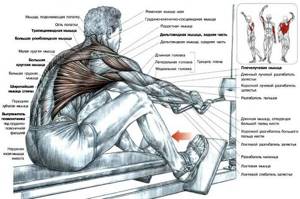
Errors and nuances
When performing an exercise such as a pull-down, you need to make sure that your elbows are pressed to your body. If they are placed to the sides, this will not lead to anything good. It is thanks to the elbows pressed to the body and the shoulder blades pulled back as far as possible that this exercise allows you to well load the latissimus dorsi muscles, or rather, their lower part.
If you spread your elbows out to the sides, the load will shift to the upper back, middle trapezius muscles and rhomboid muscles. Thus, the exercise simply will not fulfill its main purpose.
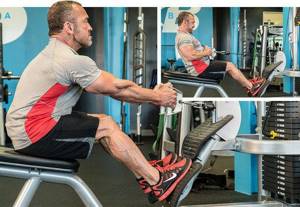
The torso, as already mentioned, must be vertical throughout the entire movement. However, slight deviations at the beginning and end of the movement are acceptable. They should not exceed 10 degrees. The limited amplitude of the torso is determined by the need for protection against injuries to the lower part of the spine.
The exercise can also be done with a straight bar, that is, the palms will look down and not at each other. If you grab the bar and point your elbows out to the sides and up, the middle part of the trapezius muscle, the back of the deltoid muscle and the rhomboid muscle will be involved in the work.
If the crossbar has a bend in the middle, and its ends are facing back, then by pointing your elbows down and towards the body, you can almost completely eliminate the delta from working. But if you point your elbows up and to the sides, then the deltas will participate in the movement very actively. Both options work well on the trapezius and rhomboid muscles.
It turns out that traction to the belt of the lower block with different positions of the elbows and the use of various crossbars allows you to deeply work out all the muscles of the back: the latissimus, rhomboids, trapezius, round and, finally, the posterior bundle of the deltoid muscles of the shoulder.
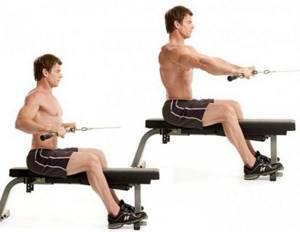
Iron Health
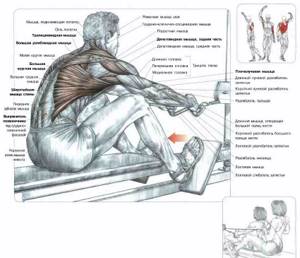
The exercise “Lower pull-down to the waist (stomach)” is a basic exercise for training the back and involves mainly the latissimus muscles. It also indirectly targets the biceps, triceps, deltoids, forearms, lower back muscles, quadriceps and hip flexors. This movement is one of the best for giving the back visual width and is used by almost all professional athletes.
Basic requirements of the exercise
Traction of the lower block to the waist while sitting requires compliance with certain conditions that will make it as effective as possible.
- The height of the seat should be such that when moving the cable is parallel to the floor at all times.
- There should be support for the feet that prevents the body from slipping when moving forward.
- Choose a handle with your palms facing each other.
Technique for performing lower pulley pull-downs to the waist
- Grasp the handle with both hands and pull it towards you. Maintain an upright body position.
- Start pulling the handle toward your waist until the handle touches your body and your elbows are no further than your torso line. Feel the strongest contraction of the latissimus muscles. Stay at this point for 1-2 seconds.
- Slowly return the handle to its original position. After that, start a new repetition.
Practical tips and advice
- The main condition for the effectiveness of the exercise is the elbows pressed to the body, due to which the lower latissimus muscles and lower pectoral muscles receive the maximum load. If you spread your elbows to the sides while moving, the maximum load will be taken by the top of the latissimus, the middle of the trapezius and the rhomboid muscle.
- When performing block rows to the belt while sitting, the deviation of the body from the vertical should not be more than 10 degrees. The more the body deviates from the vertical, the higher the risk of lower back injury.
- By changing the handle and grip, you can shift the load to other areas of the back. For example, if you take a straight bar with an overhand grip and point your elbows up and to the sides, the load will shift to the middle trapezius, rhomboid muscle and rear deltoids. When using a mid-curved handle, the elbows can be pointed down and toward the torso or up and out to the sides. In both cases, the deltoids are almost completely turned off from work, the main load falls on the rhomboid muscle and trapezius.
Video on the topic : Correct execution of the lower pulley to the waist.
